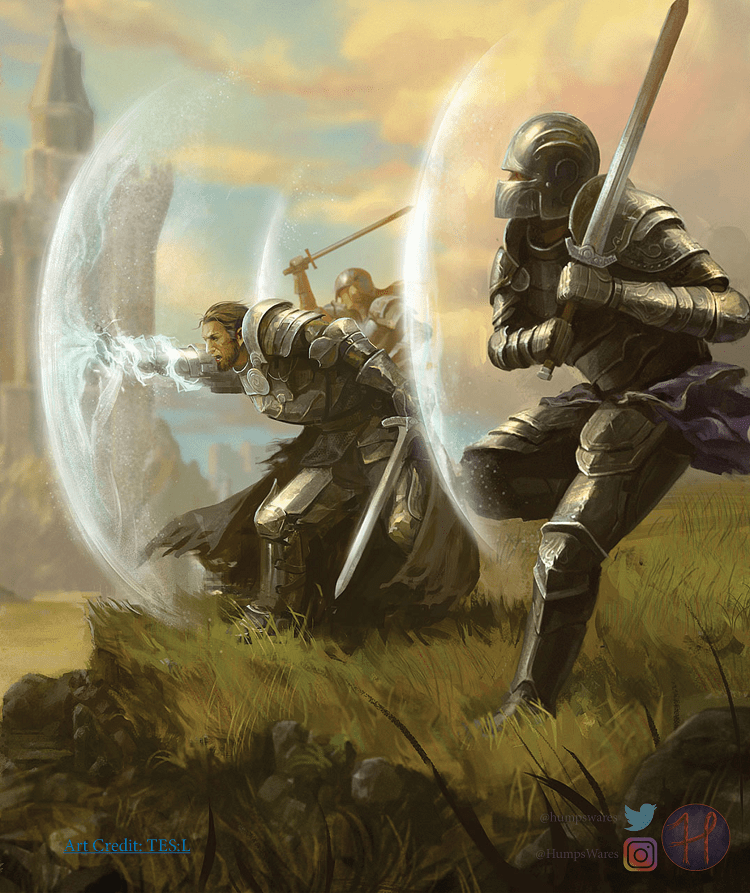Sanctuary has many meanings in a fantasy context. From a safe haven to a place that rejects certain things. It could be physical, magical, or even spiritual. A sanctuary is sacrosanct and exists to protect others.
In more recent usage, especially in D&D, Sanctuary has become a spell to form a defense. I value this Abjuration spell quite highly as its use extends beyond what is listed on the spell itself. Though it took a few years of playing with the spell as a player and even more as a DM, I believe this spell has good potential.
With this in mind, let’s kick off our Sanctuary 5e guide.
What Does Sanctuary Do?
Sanctuary is a bonus action to cast and lasts for one minute. It targets a creature within 30 ft and has no material cost, so it can be cast from just the focus.
It is a defensive spell that protects the target creature so long as that same creature does not attack or casts magic that affects enemies.
It defends by making enemies have to roll a Wisdom saving throw. On a failure, they must choose a new target for their attack or spell. If there is no target, they must stop their action.
All the Little Details
For one thing, this is not a concentration spell, and for another, this is a 1st level spell. As a whole, this is what Sanctuary does.
| Casting time | 1 Bonus Action |
| Range | 30 ft |
| Target | A Creature within range |
| Components | Verbal, Somatic, Material |
| Duration | 1 Minute |
It is a protective spell that wards one singular creature with this effect. Enemies must succeed on a Wisdom saving throw or be forced to attack a creature different from the warded creature or stop their attack entirely. The effect lasts for the duration or until the creature attacks an enemy or casts a spell that affects an enemy.
A simple spell but entirely unbreakable under the right circumstances.
Usage

As the previous section shows, this spell is not exactly flashy or very complicated. However, unlike damaging spells, the simplicity of this spell allows us to create situations to take advantage of this spell. Of course, harmful spells can be used in any circumstance, while this one has more particular situations.
Generally, you want to cast this after you have taken action to attack or cast an offensive spell. If you are casting on an ally, it would be best to make sure that they have either taken their turn already or are not going to be attacking.
You want to get as much effectiveness out of this spell as possible, so making sure that the target does not break the spell is critical. Otherwise, there are many better spells that you can use that spell slot for.
I usually find myself casting this when I plan on tanking many enemy attacks or jumping into a swarm of enemies as a distraction. This spell tends to fail against massive creatures or legendary ones as they tend to have high saves or legendary resistance to plow through it.
In more specific situations, if there is a lot of healing needed to go around or in cases wherein my damage either won’t hit or will not amount to much, I decide to cast Sanctuary and start supporting instead.
A note for the former, though, does apply to the latter. Surprisingly, this spell stays relevant at later levels as the monsters and creatures that attack your party en masse usually have difficulty making a Wisdom saving throw against a properly equipped caster.
Add to the fact that it is a bonus action and frees up your action for other activities means that you can interact with the map or try and set up for your allies.
Fun fact, you can cast this spell on a downed ally if you think getting closer to them or healing them is a wrong move, as even unconsciously, they are considered creatures. You can also target enemies and strangers with this spell, as there is no consent clause.
While this is a leveled spell, meaning that you cannot cast another leveled spell as your action, here are a few alternatives you can do rather than wasting the effort.
The Action Economy is in Shambles
Nothing ever goes wrong with using your action before casting this spell, whether attacking or doing something else. This section is more for if you decide to cast this first and use your action second, perhaps to dip around attacks of opportunity or to get through held actions with a minor investment.
Consumables are one thing you can do using your primary action, from healing potions to traps or anything in between. Since it is not considered an attack nor a spell, even if the item you use does end up harming an enemy, it would not break the Sanctuary.
This is a great way to set up a defensive position or heal allies when spell slots run low. You can even use it to take potions with more unique effects that could change the upcoming turns.
Another thing you can do is to take the dodge action; it makes you harder to hit when they can hit you. It is a secondary line of defense, and tanking adds even more obstacles on top for enemies to attempt murdering you.
A high armor class, a saving throw to attempt attacks, and a disadvantage to attack rolls make it seem futile to try and harm you. It could lead to enemies avoiding you together, so ensure that you are the only option to attack or that your allies are aware of the possibilities.
You could take this time to stabilize downed party members and move them aside to a safe location away from massive areas of effect abilities. Perhaps make skill checks to figure something out or an active perception check to spot a hidden enemy or contraption.
While not directly involved in combat, awareness of the whole situation might help your party out of a bad situation or, worse, a trapped room.
Lastly, you can take the help action. This would provide the next ally advantage on an attack roll against an enemy within 5ft of you or give an advantage on the following skill check that the ally you target makes, so long as they attempt it before your next turn.
The effectiveness of these actions depends on what you have and your stats, but generally, they are good alternatives. You can still dash and disengage if you want to, but normally, walking by should be fine unless you are trying to get somewhere fast.
Who Can Cast it

You may know that all clerics can cast this spell. However, there are a few classes wherein their subclasses can also pick this skill up.
Clerics (Domain of Peace)
Clerics can choose to have this spell prepared when they learn it at level one. It fits them as a form of protection for themselves or others; since Clerics would most likely be healing or supporting the party, they would not break the spell, giving them room to maneuver around and not get hit.
It also helps that Clerics have an excellent Wisdom score and sometimes high AC to make them doubly tanky on top of the Sanctuary benefits.
Special mention for Domain of Peace Clerics who have the spell as part of the Domain spells, meaning that it is always prepared.
Artificers
The Eberron addition to the list of classes that D&D has. This class is a half-caster closer to a three-quarters caster than anything else.
Depending on their subclass, they are either good at the damage, tanking, or control. In all states, they are rarely the ones attacking directly, so having this spell in their back pocket is a boon to keep them safe as they are still half-casters rather than tanky martial classes.
Of course, this would imply that you are leaving your actions to your turrets or robot companion to do the damage while you stay and assist it through spells and buffs. The tanky subclass would find Sanctuary less effective since they need their actions and bonus actions to either keep fighting or stay alive in a melee.
Paladin With Oath of Devotion, Oath of Redemption
We are heading into subclass territory as Paladins do not naturally gain this spell. Instead, the Oaths of Devotion and Redemption gain this as their oath spells. This is constantly ready and always able to be cast while also not taking up slots of spells prepared.
It makes sense since Devotion is to protect oneself to fulfill the cause, while Redemption is about giving others a second chance at their cause. It’s nice to see the flavor and mechanics work in tune together.
Warlock of the Genie
Released in Tasha’s Cauldron of Everything, you can already imagine how powerful this pact is, given how much the book changed the meta of the game. Genie Warlocks must choose or be chosen by a specific type of genie, and the one that provides Sanctuary is the Dao genie, also known as the Earth Elemental genie.
It makes sense that you can protect yourself while aligned with the Dao, as the earth has always symbolized stability and a solid defense in most media.
Monk of Way of the Open Hand
Okay, so hear me out. Technically, Monks do not have Sanctuary per se, but Way of the Open Hand Monks learn a feature that grants to its effects. Its level eleven ability, Tranquility, allows them to gain the effects of a Sanctuary spell until their next long rest.
Longer duration in exchange for it coming in much later in the game seems fair to me.
Is it Good

I would say that it depends on the level of play. Compared to other spells, its applications are not as commonplace, but it truly fills in the role it stands for when necessary.
What makes it good is that it has a fast casting time, and it is not concentrated at the same time. This makes it stand out amongst the other defensive spells, as it can keep pace in an offense-based game like D&D.
Its effect is powerful against mobs of enemies and weak against massive enemies with large stat pools. However, the spell provides a safety net that no other spell can create, as it can force the enemy to miss their attack or waste their action.
On top of that, it also lasts so long as you do not attack; a whole minute is ten rounds in combat which could change drastically in that period.
DMs out there, a tip I want to give you is about how clever the monsters you are running are. For example, zombies would not notice the difficulty in attacking a target, so they might wail at it fruitlessly. In contrast, a mage or a bandit might see some trickery afoot and avoid the shielded target.
I would say that it is good, given that it is a 1st level spell, non-concentration, and has a casting time of bonus action means that it is a powerful defensive spell to be cast mid-combat. However, it has shortcomings, so that I would rate it an 8 out of 10.
Combos
There are many ways to use this spell, from simple positioning to more complicated builds and sequences you can take. I will not list every single one specifically but rather the more generalized actions you can take under Sanctuary.
Summoning
Since Sanctuary will not break unless the warded creature attacks or casts an offensive spell, you can summon a creature and make it attack someone else. The wording states that “casting a spell that affects another creature” will break it, so by summoning, that spell does not affect another creature but creates a creature.
Commanding another creature to attack also does not break Sanctuary, so Artificers with their turrets, or generally any summoning spell, works wonders.
Illusions
This is a little more wording specific. The general rule is that if the illusion affects a space rather than an individual, then it is okay. However, the closer it gets to affecting an enemy harmfully, the more up to the DM’s interpretation it is. Some illusion spells that for sure work are Minor Illusion, Silent Image, and Hallucinatory Terrain.
Another good hint is to see if the spell damages or has a debilitating effect on casting the spell. If this is the case, then it will break Sanctuary.
Maintaining Spell Effect
These would be Dominate spells, effects that are already in play and need action to maintain, and concentration spells with debilitating effects. While it may seem counterintuitive to maintain these, they have missed the timing window to break Sanctuary and are perfectly fine to keep concentration on.
Of course, if the spell damages, it would break the Sanctuary, at least in my opinion. Here we get into an awkward zone known as Rules as Written (RAW) vs. Rules as Intended (RAI).
RAW, the moment the spell is already in play, Sanctuary would have no effect over it, even if it was doing consistent damage. However, RAI, any hostile action would break the peace.
Ultimately, it’s up to the individual DMs for the final say.
Buffing

Post-Sanctuary, you can still cast Buff spells since they target “allied” creatures rather than enemies. If you want to cheese a boss with Haste, it will not work since it is an “enemy.” Simple as that.
Tanking
You can take many actions to stay alive longer and effectively keep enemies at bay. You could heal yourself, increase your AC, or take the dodge action, to name a few. It gives you a final stand vibe while you watch relentless swarms of enemies trying to attack you and failing.
Special Mentions
- Abjuration Wizard
- Since Sanctuary is an Abjuration spell, your Arcane Ward would refill by casting it.
- Lore Bards
- RAW and RAI agree that Cutting Words is neither an attack nor a spell, so even if you insult enemies to the point of missing your allies, it still flies under Sanctuary’s restrictions.
FAQs
Question: Can You Cast Sanctuary More than Once?
Answer: Yes, so long as you do not cast it on yourself. In D&D, you cannot stack spells with the same name on the same target. However, Sanctuary can be cast on other creatures while maintaining each previous cast for one minute.
Question: Does Grapple Break Sanctuary?
Answer: Yes, if you initiate it after casting the spell; no, if you are maintaining a grapple against a creature after casting the spell. To start a grapple, you must make an attack roll against the target creature, which would break the restriction on Sanctuary.
Question: Do Spirit Guardians Break Sanctuary?
Answer: Yes, it does if you cast it pre-Sanctuary; no, it does not if you cast it post-Sanctuary. Spirit Guardians do damage upon summoning and every succeeding turn afterward. So it would break the restriction on Sanctuary.
Conclusion
If you are looking to hold a chokepoint or keep particular creatures safe from harm, this spell is the way to go. It’s flexible, cheap, and has lasting effects that can only be broken by a creature much more powerful than you.
- Prestige Classes 5e Guide - September 20, 2022
- Rod of the Pact Keeper 5e Guide - September 15, 2022
- Sanctuary 5e Guide - September 14, 2022

